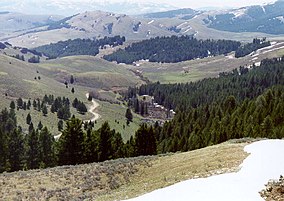Deerlodge National Forest
| Beaverhead-Deerlodge National Forest | |
|---|---|
|
IUCN category VI (protected area with sustainable use of natural resources)
|
|

Lemhi Pass in the Beaverhead-Deerlodge National Forest
|
|
| Location | Montana, USA |
| Nearest city | Butte, MT |
| Coordinates | 46°08′N 112°50′W / 46.133°N 112.833°WCoordinates: 46°08′N 112°50′W / 46.133°N 112.833°W |
| Area | 3,357,826 acres (13,588.64 km2) |
| Established | 1905 |
| Governing body | U.S. Forest Service |
| Website | Beaverhead-Deerlodge National Forest |
The Beaverhead-Deerlodge National Forest is the largest of the National Forests in Montana, United States. Covering 3.36 million acres (13,600 km2), the forest is broken into nine separate sections and stretches across eight counties in the southwestern area of the state. President Theodore Roosevelt named the two forests in 1908 and they were merged in 1996. Forest headquarters are located in Dillon, Montana. In Roosevelt's original legislation, the Deerlodge National Forest was called the Big Hole Forest Reserve. He created this reserve because the Anaconda Copper Mining Company, based in Butte, Montana, had begun to clearcut the upper Big Hole River watershed. The subsequent erosion, exacerbated by smoke pollution from the Anaconda smelter, was devastating the region. Ranchers and conservationists alike complained to Roosevelt, who made several trips to the area. (Munday 2001)
The greatest part of the Anaconda-Pintler Wilderness is located in the larger Beaverhead National Forest portion of 2,130,671 acres (8,622.52 km2), which is 64% of the total area of the forest. The rest of this wilderness extends into the neighboring Deerlodge and Bitterroot National Forests. The Beaverhead section includes most of the Pioneer, Gravelly, and Sapphire Ranges. Both the Centennial and Bitterroot mountain ranges are also located here, with the Continental divide found in the Bitterroot range. Lemhi Pass, at an elevation 7,323 feet (2,300 m) above sea level, is a rounded saddle in the Beaverhead Mountains of the Bitterroot Range, along the Continental Divide, between Montana and Idaho. Here, in 1805, the Lewis and Clark Expedition first saw the headwaters of the Columbia River, which flow to the Pacific Ocean, and crossed what was then the western boundary of the United States. Lemhi Pass was the point at which the members of the expedition realized that there was not a waterway that would lead from east to west across the continent. Lemhi Pass was designated a National Historic Landmark in 1960. The Lee Metcalf Wilderness, in the Madison mountain range, is a part of what is known as the Greater Yellowstone Ecosystem. However, most of the Lee Metcalf lies in neighboring Gallatin National Forest. The Beaverhead section lies, in descending order of land area, in parts of Beaverhead, Madison, Deer Lodge, and Silver Bow counties. There are local ranger district offices located in Dillon, Ennis, Wisdom, and Wise River.
...
Wikipedia

